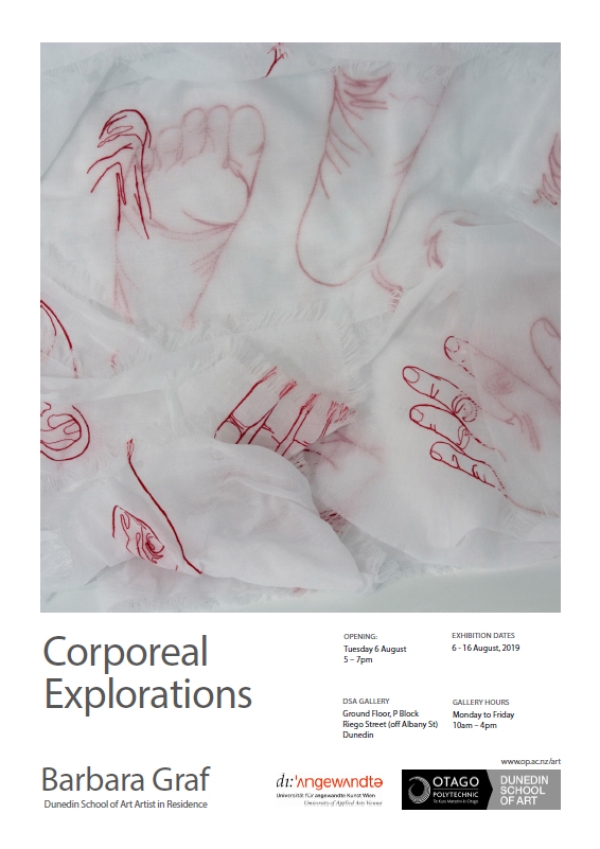Otago
Polytechnic, Dunedin School of Art
The artist Barbara Graf is Senior Lecturer at the University of Applied Arts
Vienna and in July/August 2019 she is in residence at the Dunedin School of Art. In her exhibition Corporeal Explorations
she shows textile works, photographs and films. Her field of artistic investigation is always the human body and it is also
the subject of her representation.
The artist draws body structures topographically with needle
and thread into the textile fabric - for example in the work Wrinkle Lines 4 – Bandage (Body Mapping). With a bandage that
wrapped the body from foot to head, individual parts of the body are embroidered similar to an imprint. Unwrapped and differently
arranged, the order of the body is reinvented. In photographic stagings, body fragments overlap or dissolve. The work Wrinkle
Lines 8 – Bandage (Foot-Mapping) is conceived according to a similar concept. The explicit drawing of body parts into the
medical gauze as markings indicates vulnerability, but also protection and healing.
Topographical principles are also
applied in the work of the Breast-Layers and the Hand-Breast-Layers. They belong to the series of Anatomical Garments on which
the artist has been working for 30 years. Following the anatomy of the human body, she invents shells that make the inside
visible on the outside. An Anatomical Garment consists of a sculptural multi-part clothing, a bag as storage place and transport
cover and a scientificlooking operating manual. This describes in drawings the way of acting and the presentation possibilities
of the body sculpture. In addition, the process of assembling and disassembling is depicted. It underlines the anatomical
principle, refers to the cutting pattern as well as to the conception of the body shells as a flexible sculpture. The packing
of the individual parts into the corresponding bags evokes the inherent nomadic character.
In the Cloths, the artist
uses materials that are used in the medical field - surgical drapes and medical gauze.
These works started as part of
the artistic research project Surgical Wrappings. Aim of the project was to examine artistically the operating field and gestures
of surgery. Shifted threads or embroidered lines in the textile fabric represent hand gestures and physical structures. In
the photographic arrangements, the artist brings the cloths very close to the body and the operating field transforms into
an image field. These images are able to unite ambivalent or contradictory modes in an expression of corporeality: covering
and uncovering, closeness and distance, interior and exterior view, touch and intervention. Central aspects of the images
are spaces that reach deep into the body or evaporate over the surface of the skin or sometimes exist only as embodied traces.
The simultaneity of inside and outside is also embodied in the sculpture Ear Object with Bag. It is based on the architectural
structure of the inner ear and is worn as a textile object on the outer ear. It is not without irony that this appears as
if it were an oversized piece of jewellery and can also turn into an object of visual constraint.
Transformation and
flexibility are important processes in the works of the bodily fabrics. An oversized glove becomes a garment and transforms
into performative images of curtains, draperies, organs and newly invented bodies. In her corporeal topographies, Barbara
Graf creates a fascinating and independent position of the materialisation and visualisation of an imaginary body identity,
or even self. In her works, she explores corporeality, body representation and body perception with often irritating clarity
and expressive restraint: as torsion between scientifically based investigations and poetic invention. Of course, particularity
of colour and material is inherent to this perceptual and poetic tension.
www.op.ac.nz/art



